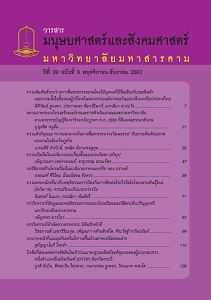ความตระหนักเกี่ยวกับพฤติกรรมการป้องกันการติดต่อ โรคไวรัสโคโรนาสายพันธุ์ใหม่ (โควิด-19) : การเปรียบเทียบระหว่างวัย
Main Article Content
บทคัดย่อ
วัตถุประสงค์ของการศึกษา คือ (1) เพื่อศึกษาความตระหนักเกี่ยวกับพฤติกรรมการป้องกันการติดต่อโรคไวรัสโคโรน่าสายพันธุ์ใหม่ (CoVid-19) (ทั้งในภาพรวมและพฤติกรรมย่อย 5 พฤติกรรม ในช่วงวัยต่างๆ (2) เพื่อศึกษาเปรียบเทียบพฤติกรรมการป้องกันการติดต่อโรค ระหว่างตัวอย่างที่มีช่วงวัยแตกต่างกัน ตัวอย่างที่ใช้ในการศึกษามีจำนวน 568 คนจากทุกจังหวัดในภาคตะวันออกเฉียงเหนือ เครื่องมือที่ใช้ ได้แก่ ความตระหนักเกี่ยวกับพฤติกรรมการป้องกันการติดต่อโรคไวรัสโคโรน่าสายพันธุ์ใหม่ (CoVid-19) มีค่าความเชื่อมั่นโดยวิธีสัมประสิทธิ์แอลฟา (a) เท่ากับ .80 สถิติที่ใช้ได้แก่ ค่าเฉลี่ย ส่วนเบี่ยงเบนมาตรฐาน การวิเคราะห์ความแปรปรวนพหุคูณ (MANOVA) และการวิเคราะห์เปรียบเทียบรายคู่แบบเชฟเฟ่ ผลการศึกษาพบว่า
- วัยกลางคนมีค่าเฉลี่ยสูงสุด รองลงมาได้แก่วัยผู้ใหญ่ วัยรุ่น ส่วนต่ำที่สุดได้แก่ วัยสูงอายุ โดย ทุกช่วงวัยมีพฤติกรรมอยู่ในระดับสูงทุกด้าน ยกเว้นในวัยรุ่น ที่มีพฤติกรรมการล้างมือและพฤติกรรมการรักษาระยะห่างทางสังคมอยู่ในระดับปานกลาง พฤติกรรมที่มีค่าเฉลี่ยสูงสุดคือ พฤติกรรมการสวมหน้ากากอนามัย พบในทุกช่วงวัย ต่ำสุดได้แก่ พฤติกรรมการรักษาระยะห่างทางสังคม พบในทุกช่วงวัย ยกเว้นวัยสูงอายุที่พบว่าพฤติกรรมที่มีค่าเฉลี่ยต่ำสุด คือ พฤติกรรมการล้างมือ
- ความตระหนักเกี่ยวกับพฤติกรรมการป้องกันการติดต่อโรคมีความแตกต่างกันอย่างมีนัยสำคัญทางสถิติที่ระดับ .05 ในพฤติกรรมการล้างมือ โดยตัวอย่างที่เป็นวัยรุ่น วัยผู้ใหญ่และวัยกลางคนมีระดับของพฤติกรรมสูงกว่าวัยสูงอายุ
Article Details
ประเภทบทความ
บทความวิจัย
เอกสารอ้างอิง
กรมการปกครอง.(2560).ประชากรกลางปี 2559. กรุงเทพมหานคร. สำนักนโยบายและยุทธศาสตร์ สำนักงานปลัดกระทรวงสาธารณสุข.
Centers for Disease Control and Prevention,(2020).Coronavirus (CoVid-19). Atlanta, Georgia. https://www.cdc.gov/coronavirus/2019-ncov/index.html.
Collins, K.M., Dantico, M., Shearer, N.B.C., & Mossman, K.L.(2004).Heart Disease Awareness Among College Students. Journal of Community Health. volume 29, 405–420.
Creative Research Systems.(2020). Sample Size Calculator. Creative Research Systems. website. https://www.surveysystem.com/sscalc.htm
Dowdy, S., Wearden, S. and Chilko, D.(2004). Statistics for research. Thirth edition. New Jersey. Wiley-Interscience A JOHN WILEY & SONS, INC. PUBLICATION.
Fidell, L.S. and Tabachnick, B.G.(2014). Using Multivariate Statistics Pearson New International Edition. Newyork. Pearson.
Hair, J.F., Black, W.C., Babin, B.J., & Anderson, R.E.(2019).Multivariate Data Analysis 8th Edition. Hampshire. Cengage Learning.
Healey, J.F. (2015). The Essentials of Statistics: A Tool for Social Research. Boston: Wadsworth Publishing.
Israel, G.D.(1992).Determining Sample Size. University of Florida Cooperative Extension Service, Institute of Food and Agriculture Sciences, EDIS, Florida.
Johns Hopkins University.(2020). CoVid-19 Dashboard by the Center Systems and Engineering (CSSE). Johns Hopkins University. https://systems.jhu.edu/research/public-health/ncov/.
Joseph, T., & Ashkan, M.(2020).International Pulmonologist’s Consensus on CoVid-19. International pulmonologist’s consensus group on COVID-19.
Kent, M. (2007). The Oxford Dictionary of Sports Science & Medicine. 3 ed. London. Oxford University Press. DOI:10.1093/acref/9780198568506.001.0001
Merriam-Webster.(2020). Merriam-Webster Dictionary. New York. Merriam-Webster.
Mosca, L., Jones, W.K., King, K.B., Ouyang, P., Redberg, R.F., & Hill, M.N.(2000). Awareness, Perception, and Knowledge of Heart Disease Risk and Prevention Among Women in the United States. Archives Family Medicine. 9, 506-515.
Porta, M.(2016). A Dictionary of Epidemiology (6 edition.). London. Oxford University Press. DOI : 10.1093/acref/9780199976720.001.0001
Privitera, G.J.(2018). Essential Statistics for the Behavioral Sciences. New York, Sage Publications, Inc.
Rubin, O. & Dahlberg, R.(2017). A Dictionary of Disaster Management. London. Oxford University Press.
Wick, G,(2020). Coronavirus 2020: What is really happening and how to prevent it (updated February 12th, 2020 Wuhan Outbreak). Grayson Wick.
Zizek, S.(2020). PANDEMIC!: COVID-19 Shakes The World. New York. OR Books.
Centers for Disease Control and Prevention,(2020).Coronavirus (CoVid-19). Atlanta, Georgia. https://www.cdc.gov/coronavirus/2019-ncov/index.html.
Collins, K.M., Dantico, M., Shearer, N.B.C., & Mossman, K.L.(2004).Heart Disease Awareness Among College Students. Journal of Community Health. volume 29, 405–420.
Creative Research Systems.(2020). Sample Size Calculator. Creative Research Systems. website. https://www.surveysystem.com/sscalc.htm
Dowdy, S., Wearden, S. and Chilko, D.(2004). Statistics for research. Thirth edition. New Jersey. Wiley-Interscience A JOHN WILEY & SONS, INC. PUBLICATION.
Fidell, L.S. and Tabachnick, B.G.(2014). Using Multivariate Statistics Pearson New International Edition. Newyork. Pearson.
Hair, J.F., Black, W.C., Babin, B.J., & Anderson, R.E.(2019).Multivariate Data Analysis 8th Edition. Hampshire. Cengage Learning.
Healey, J.F. (2015). The Essentials of Statistics: A Tool for Social Research. Boston: Wadsworth Publishing.
Israel, G.D.(1992).Determining Sample Size. University of Florida Cooperative Extension Service, Institute of Food and Agriculture Sciences, EDIS, Florida.
Johns Hopkins University.(2020). CoVid-19 Dashboard by the Center Systems and Engineering (CSSE). Johns Hopkins University. https://systems.jhu.edu/research/public-health/ncov/.
Joseph, T., & Ashkan, M.(2020).International Pulmonologist’s Consensus on CoVid-19. International pulmonologist’s consensus group on COVID-19.
Kent, M. (2007). The Oxford Dictionary of Sports Science & Medicine. 3 ed. London. Oxford University Press. DOI:10.1093/acref/9780198568506.001.0001
Merriam-Webster.(2020). Merriam-Webster Dictionary. New York. Merriam-Webster.
Mosca, L., Jones, W.K., King, K.B., Ouyang, P., Redberg, R.F., & Hill, M.N.(2000). Awareness, Perception, and Knowledge of Heart Disease Risk and Prevention Among Women in the United States. Archives Family Medicine. 9, 506-515.
Porta, M.(2016). A Dictionary of Epidemiology (6 edition.). London. Oxford University Press. DOI : 10.1093/acref/9780199976720.001.0001
Privitera, G.J.(2018). Essential Statistics for the Behavioral Sciences. New York, Sage Publications, Inc.
Rubin, O. & Dahlberg, R.(2017). A Dictionary of Disaster Management. London. Oxford University Press.
Wick, G,(2020). Coronavirus 2020: What is really happening and how to prevent it (updated February 12th, 2020 Wuhan Outbreak). Grayson Wick.
Zizek, S.(2020). PANDEMIC!: COVID-19 Shakes The World. New York. OR Books.


